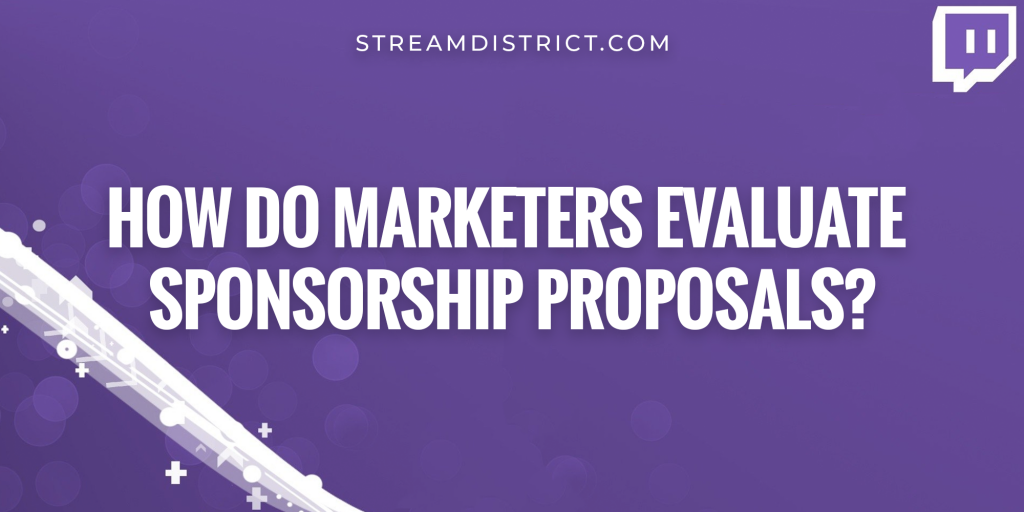Most companies who are already active in the gaming scene get buried with hundreds of sponsoring proposals each month, for both online as offline partnerships. This makes it very difficult for your proposal to stand out, and even more so to actually seal the deal.
The big question won’t be if your sponsoring proposal is a fit for the brand, rather if you are the best option out of all the opportunities and proposals that the marketing director already received. That’s why you need to research the brand and create a custom made pitch to get to the top of the pile.
Before we go deeper into the details of the perfect sponsoring proposal, we can tell you about the two most crucial factors during a pitch: creating a win-win offer and pitching it to the right person!
Is your sponsoring proposal actually a proposal?
As a marketer, I have received a numerous amount of sponsoring request; going from emails with detailed sponsoring-files, to a twitter DM containing less than 140 characters. I don’t think I need to tell you which ones were more appealing.
Here are a few tips to make your intro a bit more appealing, improving your chances for a partnership:
- Did you make an actual offer, or did you just send over an email with the information about whom you are? Give the marketeer an idea what you’re looking for, and what they’ll get in exchange. Don’t expect them to make you an offer.
- Natura, Value or Cash? You are probably contacting this sponsor, because it’s a perfect match with your brand. Most of the times, this means you’re already fan of their products, and are using it yourself. This means you could potentially ask for a compensation in natura (free product), value (present on their channels and events) or in cash.
Did you fail before you had a chance?
After spending months working on your sponsorship proposal, you email it out to everyone on your list — then nothing happens. You double check the contact details, email message and sponsor file for typos and errors and find a massive mistake. If you can’t manage to send out a professional sponsoring pitch, possibly financing your next online adventures, why would you be able to represent the brand without making any mistakes?
What are the most common mistakes?
- Rookie mistake: Was the sponsor file attached?
Forgetting to attach a file is one of the most common mistakes to make.
- Approached the partner too soon
The first impression matters and when it comes to sponsors, the wrong first impression could leave you empty handed and might ensure that they won’t review your proposal in the next foreseeable future. That’s why it’s important to only approach sponsors when you can offer them something unique, something that other streamers can’t match.
- Approached the wrong person
The reason you don’t want to pitch the gatekeeper or someone random in the company you want to partner with, is because it’s not their job to handle sponsor request and they don’t care about your project. Again, they are gatekeepers – not decision makers. Pitching them will mean nothing, and all it will do is annoy them and waste your time.
Tip: You’ll need to look for the brand manager or the marketing manager.
- Standard proposal
I’m willing to bet you that 99% of the offers that were submitted before yours included the same proposal: Logos in stream, mentions on twitter, and maybe even a placement on the merchandise. If this type of proposal didn’t interest them before, it probably won’t interest them now; get creative and make a custom proposal!
- Don’t propose sponsorship levels.
No-one is interested to see what a “Gold partner” will receive, when they are only going for a “Bronze partnership”.
- Don’t send search-and-replace proposals.
It’s pretty obvious to start with, and again: we don’t want to send a standard proposal. You need to create a unique deal offer for each potential partner.
- Don’t change your prices depending on the partner.
Sponsors talk and won’t hesitate to ask others brands about their experience with you, or to double check how much your offer is actually worth.
Is the proposal about the brand, or about yourself?
To be absolutely honest; the marketeer probably only wants to know how you can help him increase the sales volume, so make your proposal about them.
- Does this fit with the brand values?
The first question they’ll be asking, is if it makes ‘sense’ to partner up with you. Does you and your niche community influence their target audience? Do you create cool content? Are you visiting the same type of events? Do you have the same values and goals?
- How many extra products will you sell by accepting this partnership?
Most marketers have a ‘key performance indicator’ that will impact their performance and goals. This will probably be a sales-driven goal. That’s why most marketers will ask themselves, “will this partnership get us to sell extra products? If so, how many?”
- Are there business cases or examples?
You already managed to convince one sponsor? Use it to inspire the marketer, show them their trust in you and seal your second deal!
What are the practical tips?
- Do your homework
Know who you are talking to, what their target audience is, and how they are currently achieving their goals.
- Try to find brands who’re not active in the scene yet
If you aren’t sponsored yet, this probably means that your numbers aren’t high (yet). It makes no sense to already approach the big wales who receive 20+ requests per day, so start with the smaller brands who are active in your area but haven’t got a local ambassador yet.
- Meet them in person
Everyone who’s active in the same scene as you visits offline events. From educational meetings, to big game expos. They are probably attending the same events you are, so try to meet them offline before you drop them a cold email.
- Don’t offer before you know the brand’s goals
We want to send out a personalized ‘on brand’ proposal, so before we send something out we want to do our homework and adjust our offer accordingly. This is why we need to know about the upcoming events, new product launches, and their main social media channels.
- Don’t forget your personal branding
First impression is everything, so make sure to include a small bio, pictures, a list of social media links, and a list of your current partnerships into your sponsor file. Don’t forget to ‘clean up’ your social media accounts, because they’ll probably check them out.
- Look for partners, not sponsors
You want to create a win-win situation, not just find a brand that donates money in exchange of some on screen logos. Bonus tip: make sure your partnership can be measured! - Contact them in September
There are three reasons why you should contact your potential gaming partner in September:- Most game releases, promos and event are happening in October
- Most brands will already know in September if they’ll have budget left, so they’ll be able to try some new things out
- Marketers are probably already planning for the next year, and might include you in these plans!
Conclusion
Getting sponsorships is a tricky business, and depends on different factors. It’s definitely not easy to find a partner, so make sure you bring your A game!

